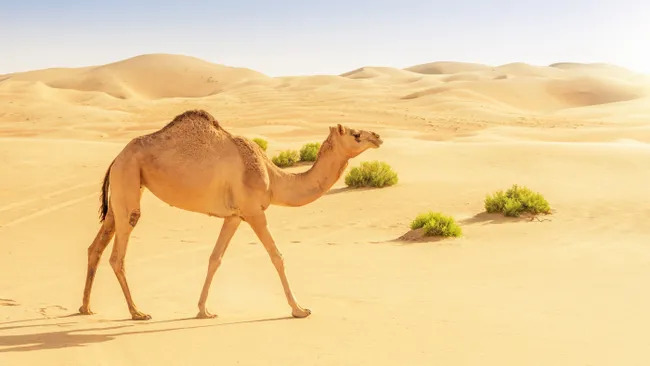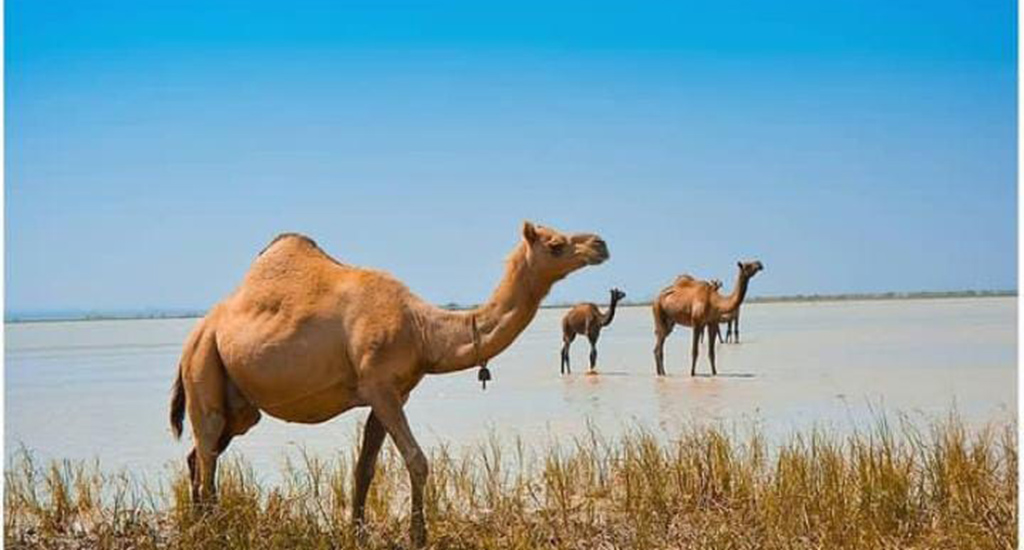Table of Contents
ToggleTop 30 Amazing and Interesting Facts About Camels
Amazing creatures, camels are renowned for their capacity to endure and flourish in some of the most hostile habitats on the planet. Camels, often known as the “ships of the desert,” have been an essential element of human civilization for ages, especially in arid places such as the Middle East, North Africa, and Central Asia.

The dromedary, which has one hump, and the Bactrian camel, which has two, are the two primary species of camels. When food is in short supply, fat stored in the hump (or humps) can be transformed into energy and water. Because of this adaptability, camels can survive for extended periods of time without food or water, which makes them ideal for living in the desert.
In addition to these special traits, camels can withstand harsh environments. Their big, padded feet keep them from sinking into the sand, and their long eyelashes and closable nostrils shield them from the sun. Camels can also tolerate temperature swings that would kill most other animals, which allows them to survive the harsh desert nights as well as the scorching days.
Camels have been utilized for transportation throughout history, moving people and goods over wide stretches of desert. Moreover, their wool, meat, and milk are prized. Camels have a particular role in many civilizations as representations of tenacity, fortitude, and survival.
Many people who live in deserts still rely heavily on camels for their daily needs. These resilient creatures continue to be a famous and vital aspect of desert life, even in the face of technological and transportational breakthroughs.
In this blog, we’ll explore 30 amazing facts about these incredible animals, diving deep into their biology, behavior, and cultural significance.
1. Two Types of Camels
- Camels come in two main species: the Dromedary, which has one hump, and the Bactrian, which has two humps. Dromedaries are commonly found in the Middle East and Africa, while Bactrians are native to Central Asia.
2. The Purpose of Humps
- Contrary to popular belief, camel humps do not store water. Instead, they store fat, which camels can metabolize for energy when food is scarce. This fat reserve allows them to survive in the desert without food for several weeks.
3. Water Conservation Experts
- Camels are incredibly efficient at conserving water. They can drink up to 40 gallons of water in one go when they find a water source and can go without water for several days, sometimes even weeks.
4. Thick Fur for Temperature Control
- Camels have thick fur that insulates them against the scorching desert heat during the day and the freezing temperatures at night. This fur also helps them to sweat less, conserving water.
5. Long Eyelashes and Closing Nostrils
- To protect themselves from sandstorms, camels have long eyelashes that trap sand particles and nostrils that they can close at will. This adaptation ensures that they can survive even in the most severe sandstorms.
6. Wide, Padded Feet
- Camels have wide, padded feet that prevent them from sinking into the sand. These feet also help distribute their weight evenly, making it easier for them to walk on the soft desert terrain.
7. Incredible Endurance
- Camels are known for their endurance. They can travel up to 100 miles in the desert without food or water, making them the perfect companions for desert nomads and traders.
8. Camels and Humans: A 3,000-Year-Old Partnership
- Camels have been domesticated by humans for over 3,000 years. They have been used for transportation, carrying goods, and even in warfare. Their ability to travel long distances without water made them essential for ancient trade routes, such as the Silk Road.
9. Milk: A Nutrient-Rich Superfood
- Camel milk is incredibly nutritious, containing three times the amount of vitamin C found in cow’s milk. It is also rich in iron, potassium, and essential fatty acids. In some cultures, it is considered a superfood and is used for medicinal purposes.
10. Camels Can Drink Salt Water
- Unlike most animals, camels can drink salt water. Their kidneys are highly efficient at filtering out the salt, allowing them to stay hydrated even when freshwater is not available.
11. Adapted to Harsh Climates
- Camels can withstand extreme temperatures ranging from -20°C (-4°F) in the winter to 50°C (122°F) in the summer. Their bodies are perfectly adapted to survive in these harsh environments.
12. Low Urine Output
- To conserve water, camels produce very little urine. The urine they do produce is highly concentrated, allowing them to retain as much water as possible.
13. Camel Racing: A Popular Sport
- In many Middle Eastern countries, camel racing is a popular sport. Camels can reach speeds of up to 40 miles per hour in short bursts and maintain a speed of 25 miles per hour for longer distances.
14. Social Animals
- Camels are highly social animals and live in groups called caravans. These groups are usually led by a dominant male, and the camels form strong bonds with each other.
15. Unique Digestive System
- Camels have a unique three-chambered stomach that allows them to efficiently break down tough desert vegetation. This system enables them to extract the maximum amount of nutrients from their food.

16. Lifespan and Reproduction
- Camels have a lifespan of about 40-50 years. Female camels give birth to one calf after a gestation period of around 13 months. The calves can walk within hours of being born, which is crucial for survival in the wild.
17. The Role of Camels in Desert Ecosystems
- Camels play a vital role in desert ecosystems. They help disperse seeds through their droppings, which contributes to plant growth in the desert. Additionally, their grazing helps to prevent overgrowth of certain plant species.
18. Camel Leather and Wool
- Camel leather is highly durable and is used to make a variety of products, including bags, shoes, and saddles. Camel wool, on the other hand, is soft and insulating, making it ideal for clothing and blankets.
19. Cultural Significance
- In many cultures, especially in the Middle East and North Africa, camels are revered and hold significant cultural and economic importance. They are often featured in art, literature, and folklore.
20. The Camel’s Unique Gait
- Camels have a unique gait called “pacing,” where both legs on the same side move forward simultaneously. This gait helps them maintain stability and balance on uneven terrain.
21. Camels and Religion
- Camels are mentioned in various religious texts, including the Bible and the Quran. In Islam, camels are considered a symbol of patience and endurance.
22. Camel Beauty Contests
- In some parts of the Middle East, camel beauty contests are held, where camels are judged based on their appearance, including the size and shape of their humps, the length of their eyelashes, and the grace of their walk.
23. Camels Can Recognize Human Voices
- Studies have shown that camels can recognize and respond to the voices of their owners. This ability to distinguish between different human voices is a sign of their intelligence and social nature.
24. Camels and Warfare
- Throughout history, camels have been used in warfare due to their ability to carry heavy loads over long distances. They were used by various armies, including those of the Persian Empire and the Islamic Caliphates.
25. Surviving on Little Food
- Camels can survive on very little food. In times of scarcity, they can eat almost anything, including thorny plants, bones, and dried leaves. Their ability to extract nutrients from such tough materials is remarkable.
26. Camels and the Silk Road
- Camels played a crucial role in the success of the Silk Road, the ancient trade route that connected the East and West. Their ability to carry heavy loads over long distances without water made them indispensable to traders.
27. Desert Adaptation: Sweat Regulation
- Camels sweat very little, even in extremely hot temperatures. Their bodies are designed to tolerate high levels of dehydration, which helps them conserve water in the harsh desert environment.
28. Camel Meat: A Staple in Some Cultures
- In some cultures, particularly in the Middle East and North Africa, camel meat is a common food source. It is considered a delicacy and is often served during special occasions.
29. The Role of Camels in Modern Medicine
- Camel milk and urine are used in traditional medicine in some cultures. They are believed to have healing properties and are used to treat a variety of ailments, including diabetes and digestive disorders.
30. Camels as Symbols of Resilience
- Camels are often seen as symbols of resilience and endurance. Their ability to survive and thrive in some of the harshest environments on Earth makes them a powerful representation of adaptability and strength.
Conclusion
One of the most amazing things that nature has to offer are camels. They have been able to not only survive but also flourish in some of the most hostile places on Earth thanks to their special powers and adaptations. Camelbacks never cease to amaze and inspire us, from their incredible endurance to their cultural significance. As we learn more about these intriguing species, we develop a deeper understanding of their role in the natural world and the various ways they have contributed to human history and culture.
Camels are a symbol of nature’s inventiveness in the vast and merciless deserts. They are among the most fascinating species on the world because of their tale of survival, adaptation, and resiliency. Nobody can deny that camels are incredibly remarkable animals deserving of respect and admiration, regardless of whether they are wildlife enthusiasts or just naturally curious about the world around them.

